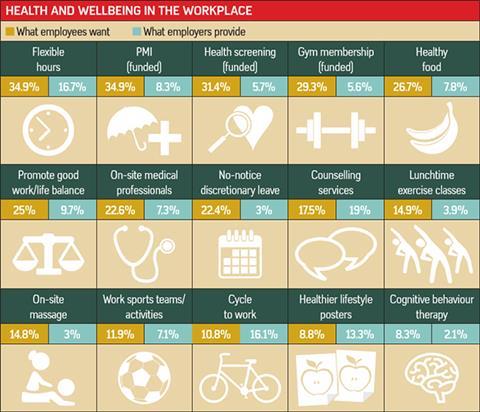
If you read nothing else, read this…
- One of the oldest approaches to motivating staff is the carrot-and-stick method.
- Health assessments can play a role in inspiring employees to make healthier lifestyle choices.
- The success of a health and wellbeing strategy depends on managers leading by example.
Workplace health is difficult for employers to manage at the best of times, but particularly so in winter.
As well as the health-related problems already facing o rganisations, such as the rising tide of obesity and consequent health issues such as type 2 diabetes, coronary heart disease, high blood pressure, strokes and certain cancers, employees are more likely to reduce their daily physical activity and to comfort eat, drink and smoke more than usual at this time of year, particularly over Christmas.
Also, staff may be suffering increasing stress caused by a fear of the future and the uncertainty of employment, as well as inadequate retirement savings.
So how can employers motivate staff to be healthy? Will motivation alone work or is enforcement the only approach that will achieve results?
Carl Chapman, head of wellbeing at actuarial, administration and consultancy services provider Barnett Waddingham, says: “I think motivation stems from within, so employers cannot enforce motivation.”
Chapman says employers should also consider the legal implications of forcing staff to be healthy.
Techniques to boost staff health
One of the oldest approaches to motivating staff is the carrot-and-stick method.
Techniques such as financial incentives could give staff an extra push to take care of their health, as could perks such as discounted gym membership or a year’s free medical insurance.
Health assessments can also play a role in motivating staff to make healthier lifestyle choices. For example, an employee who is shown that the impact of their unhealthy eating habits and lack of daily activity may lead to diabetes could be forced into reviewing their behaviour.
Employers could also consider penalties for staff who failing to hit agreed health targets in an attempt to make them work harder to be healthier.
For example, some Middle Eastern organisations offer different types of sick pay depending on whether an employee has had a flu jab.
Dr Mark O’Connor, managing director at occupational health provider Work Doctors, says: “This is an extreme form of enforcement, which I have seen, and it is something the UK could not do for ethical reasons. It really does put pressure on employees to be healthy.”
But Rebekah Haymes, senior consultant at benefits consultant Towers Watson, says: “Enforcement comes into play and takes over from motivation because employers want to have a responsibility to change their employees’ lifestyle and it is good that an organisation does so. It is also good for business.”
Business benefits of a healthy workforce

Edenred’s paper Health and wellbeing at work: The need for cultural change research , published in November, found that UK employers are increasingly embracing health and wellbeing strategies to improve their business performance , with more than one-third (37%) of respondents saying it is core to their people strategy and they plan to increase investment in this area next year.
But Iain Laws, managing director at benefits consultancy Jelf Employee Benefits, says the success of a health and wellbeing strategy depends on managers leading by example.
“Like any management culture, a successful organisation comes from the top down, and a healthy culture is no different,” he says.
Yorkshire Water is a case in point. It uses senior managers’ commitment to their own health to inspire, motivate and engage staff in the organisation’s health and wellbeing strategy, which is designed to help create a healthy workforce.
Mike Tyler, a partner at Lockton Benefits, says employers also need to build a culture that helps to support healthy behaviour by employees.
“You cannot have motivation or enforcement if there is no evidence of a healthy culture within the organisation,” he says. “If employees see their leaders working long hours, it plays down to the workforce.”
Targeted communication strategies
Communication is an integral part to any motivation or enforcement strategy , and segmented messaging can help employers to engage and support staff who most need to improve their health. However, organisations must be careful not to breach discrimination legislation in the process.
Employers must also be mindful of the fact that employees may not want to share their health data, so their communications campaigns may have to be more general than they would like, although this does not necessarily mean they will be less effective in motivating staff.
However, employers must first ensure their benefits package supports their efforts to motivate staff to be healthy.
Stephen Hackett, head of health and risk at Aon Employee Benefits, says: “Most employers now have a rich set of benefits that most have not reviewed. They simply have to relook at their health benefits to get employees thinking differently and create a healthier workforce.”
Susan Gee: Workplace health strategies are not rocket science

Improving workplace wellbeing is about enabling employees to maximise their personal resource and, in particular, to create a good work-life balance.
Creating an organisational structure that enables employees to flourish and take pride in what they do is not rocket science, but it requires employers to be structured and committed in their approach.
Employers should adopt a holistic approach to health and wellbeing , supporting employees to function to the best of their abilities, both as individuals and in collaboration with their colleagues.
We are proactive rather than reactive to health issues faced by employees, focus on the prevention of injuries and illnesses, and effectively manage an employee’s return to work after a period of absence.
Employee wellbeing strategy
Our employee wellbeing strategy focuses on three main areas: health and safety, management of ill-health, and prevention and promotion.
Initiatives in the health and safety area are driven by government policy and shaped by statutory requirements such as the Health and Safety at Work Act (1974), while management of ill-health helps employees’ rehabilitation back into work , supporting those with chronic health conditions and long-term disability to remain at work.
Elsewhere, prevention and promotion identifies health risks in the workplace and health promotion campaigns, which acknowledge public health issues that impact on health in the organisation.
Key themes
The key themes that are integral to the success of wellbeing at work are a result of having an organisational commitment to improving the health of the workforce, involving employees in the decision-making processes and developing a working culture that is based on partnership and trust.
Organising work tasks and practices so that employees contribute to, rather than damage, health, and implementing policies and practices that enhance employee health by making safe and healthy choices easy, help to create a healthy workforce.
Senior management commitment, as well as supervisory support and leadership, is also of major importance in securing the engagement and participation of employees in their wellbeing strategy.
It is essential that senior management support for wellbeing is visible and genuine, as there is evidence that this, coupled with exemplary leadership behaviour, enhances the commitment and participation of employees.
Susan Gee is occupational health and employee wellbeing manager at Yorkshire Water
Case study: University of Sheffield motivates employees with online health portal

The University of Sheffield motivates its employees to keep healthy via a free health and wellbeing portal.
The portal, Juice, was launched for more than 7,000 staff in November 2012 and aims to allow employees to make informed lifestyle choices, adopt healthier behaviours and go beyond their expectations and existing capabilities on both a personal and professional level.
Andrew Dodman, director of human resources at the University of Sheffield, says: “We did not want to have the traditional approach of writing a policy, but wanted tocreate a healthy workforce through Juice with onsite access to activies to treat health and wellbeing holistically through physical, mental and social health.
“We felt the best way of engaging employees with their health and wellbeing was to make the drivers about the individual.”
Juice houses all of the university’s health and wellbeing services and features monthly health-related articles and campaigns for staff to read.
The organisation runs about 30 weekly activities, including boot camps, cycling clubs , tai-chi, book clubs and staff choirs.
Staff take-up has been strong, with more than 10,000 regular visits to the Juice website and more than 30% of employees attending at least one activity session.
Dodman adds: “There is a strong obligation [at the university] of wanting staff to be healthy and happy. We are not doing it for the traditional corporate drivers, such as sickness absence, but we want staff to engage and be productive and to have that commitment and passion to work for us and use Juice as a key tool to do that.”























